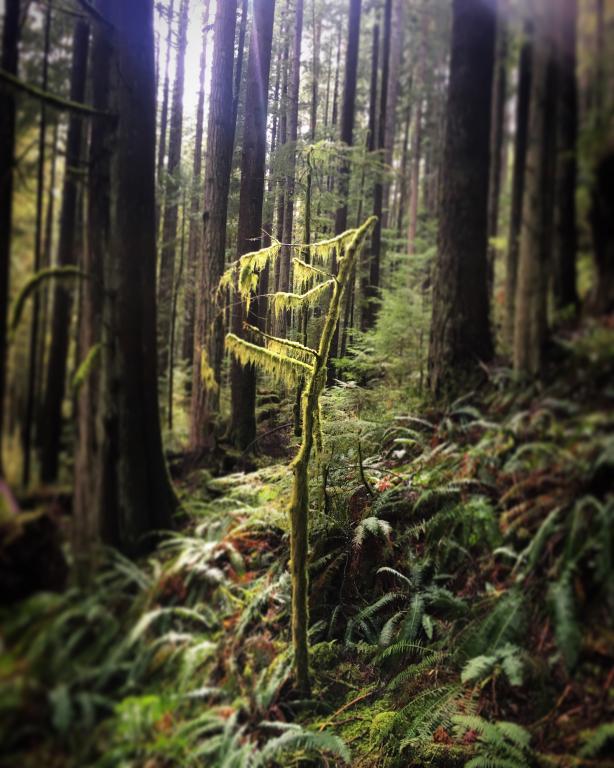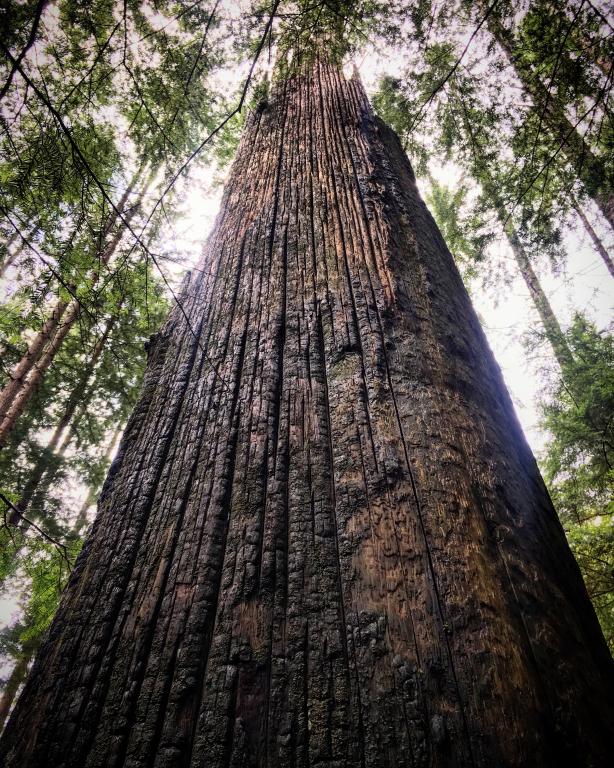 Back in 2011, toward the end of my master of forestry program, I began to wonder whether my newly-found knowledge of the forest was getting in the way of experiencing it. Memorizing Latin names for family, genus and species; describing the intricate details of the physiology of tree growth; categorizing the phases of forest succession; or, learning to identify diseases and invasive species. Together, these skills were allowing me to see the forest through fresh eyes. But what I found myself lacking, was those simple encounters with the raw and transformative beauty of trees and forests that go beyond our ability to name, categorize and catalogue.
Back in 2011, toward the end of my master of forestry program, I began to wonder whether my newly-found knowledge of the forest was getting in the way of experiencing it. Memorizing Latin names for family, genus and species; describing the intricate details of the physiology of tree growth; categorizing the phases of forest succession; or, learning to identify diseases and invasive species. Together, these skills were allowing me to see the forest through fresh eyes. But what I found myself lacking, was those simple encounters with the raw and transformative beauty of trees and forests that go beyond our ability to name, categorize and catalogue.
What I am exploring in this paper is the notion that a balance between naming and experiencing are complementary aspects of any spiritual ecology. Understanding, identifying and naming are powerful ways to experience the world, its utility to us and its sacramental depths. Words are symbols used to point to objects, persons, relationships and ideas. The Traditional Ecological Knowledges of any culture develops to organize life around necessary categories: food, medicine, season, friend, foe, real, hidden, etc. Our languages develop in relation to the web of life around us, to describe the properties and uses of the world. In a time of mass disconnection from ecological processes, re-learning these words, uses and processes are a powerful cultural transformation strategy.
The phrase Ecological Literacy was coined by sustainability educators David Orr and Fritjof Capra and can be paraphrased as a basic understanding of the ecological cycles and functions of the earth. Developing a sense of place, and a basic understanding of the processes, elements and organisms in our bioregions is a crucial component of ecological sustainability. In addition, as scholar Douglas Christie has written, there is a deeply rewarding complementarity between spirituality and ecological literacy. He writes:
[S]piritual thought and practice is immeasurably enriched through being situated within the natural world, and…ecological understanding is given added depth and meaning by extending the ecological field to include traditions of spiritual thought and practice.[1]
Language forms a crucial element of Christian theological spirituality. God is said to have spoken the world into being, and thus, in turn, the world speaks of God’s being. In the Gospel of John, the author affirms Jesus not just as a wise teacher, but as the Logos, or Word of God made flesh.
Naming is also an element of Biblical theology. In the Book of Genesis, Adam is charged by God to name the animals. And the very name of God is sacred to the Jewish writers.
These logo-centric analogies have often led theologians to see the world itself as a text referred to as the Book of Creation. Natural Theology proceeds from the assumption that if we are able to learn to read this Book, we will better come to know its Author. Saint Augustine (354-430) writes:
Some people, in order to discover God, read books. But there is a greater book: the very appearance of created things. Look above you! Look below you! Note it. Read it. God, whom you want to discover, never wrote that book with ink. Instead He set before your eyes the things that He had made. Can you ask for a louder voice than that? Why, heaven and earth shout to you: ‘God made me!’[2]
Creation speaks of God through its existence, beauty and diversity. This analogy continued into the enlightenment. In a letter, Galileo (1564-1642) wrote, “We conclude that God is known first through Nature, and then again, more particularly, by doctrine; by Nature in His works, and by doctrine in His revealed word.”[3]
During the enlightenment and reformation, religion and science took divergent institutional paths, which included their respective approaches to the uses of language to understand the world. In the academy today we have two schools of knowledge rooted in this political dispute between Western epistemological categories. Scientific knowledge has focused on the analytical, observable and measurable. Religious and poetic knowledge is assumed to express the realm of the subjective, the speculative, the qualitative and the mystical. For early atheist David Hume, for example, the poet expresses nothing but fabrication. He wrote, “Poets themselves, though liars by profession, always endeavor to give an air of truth to their fictions.” For Hume and the more contemporary atheist writer Richard Dawkins religion is simply outdated and bad science.[4] On the other side, for the Romantic poet Jon Keats (1795-1821), dissecting the beauty of a rainbow, as Isaac Newton’s laws of optics did, risks losing the mystery, beauty and enchantment of the world to a “cold philosophy.”
Thus the experience of a forest has often required one to take sides, the pragmatic and the economic on the one side, and the poetic and the intrinsic on the other. This is the epistemological divide we have inherited, and which we seek to overcome. In his book The Reenchantment of Nature, Alistair McGrath, a scientist and Anglican priest, insists that science is not the only valid source of knowledge about the world. For McGrath there is a balance to be struck between the two ways of knowing that are complementary:
Our appreciation of a rainbow is enhanced through an understanding of the Newtonian laws of optics. This does not detract or distract from the immediate spine-tingling sense of delight at a rainbow, or from the potential of a rainbow to point beyond itself to a realm for which we can only long in our present situation, but which we believe we shall one day enter.[5]
For McGrath, what we call the cataphatic (according to words) and the apophatic (without, or beyond words) need each other. Words and beyond words are complementary. God in the liturgy and God in silence feed each other.
This lesson is precisely what I have learned in my experiences as an amateur naturalist and more recently as a researcher working with Catholic monks. For my dissertation research, I interviewed 50 monks from four Roman Catholic monastic communities located in the American West from Benedictine and Trappist lineages. Most monks have a deep sense of place that emerges from their vow of Stability, and a rich symbolic literacy of the landscape rooted in tradition and scripture. Yet, generally, they were not interested in knowing the scientific or common names of more than a dozen common plant and animal species. They seemed to value the landscape as a spiritual resource, one that pointed sacramentally to God and as a consequence, names were of little importance. Rather, it was color, size, niche, and the qualities of an organism that interested them most.
For example, during a walk with a monk of New Camaldoli Hermitage in Big Sur, California; after he bent down to look at a small flower he said that it reminded him of the Saint Therese of Lisieux. I asked what it was. He stated unequivocally, that he didn’t know names, he just enjoyed noticing each particular thing. Saint Therese had compared herself to a little flower, and thus little flowers pointed to the teachings of this important saint, and to God’s tender care for all creatures, even the smallest of plants.
Similarly, a monk at Christ in the Desert Abbey in Abiquiu, New Mexico told me that he cultivated an intimate attention to the particularities of the land and would counsel younger monks to really look at the land when they were out walking. He would sit on a bench and contemplate small creatures, birds and plants for hours, but again, was uninterested in their common or scientific names.
Somewhat frustrated by this finding, I asked another monk at Christ in the Desert why the monks were not interested in the names of plants and animals. He said:
The important [thing] I guess for the monk, you might ask, what’s more important, to know and spend time with a flower and to know its origin which is God or to know what we’ve named it?
The assumption of course was that one activity detracts or takes time away from the other, in the classic epistemological divide between sciences and the humanities. Being a good humored man, he then began to make up the names of plants and wildflowers as we walked along: “That’s the Fred Oak” he said; or, “The Lusitania Trumpet.” The important thing was to be present to it in all its mystery, changes and seasons; the world speaks of God, and to move through the landscape is to be reminded of God through the symbolic and spiritual lessons that the landscape provides. That was the key to the monastic sense of place that I encountered.
And yet, whether scientific or theological, framing the world only through our ideas of it can be just as instrumental or exploitative as a logger or miner might be. Sacramental theology can turn the land into yet another kind of resource for human use, even if that use is spiritual. Theologian of place Belden Lane raised this criticism best when he wrote:
The challenge is to honor the thing itself, as well as the thing as metaphor. When [Ralph Waldo] Emerson declared in 1836 that ‘every natural fact is a symbol of some spiritual fact,’ he sent people racing to the woods, anticipating the voice of God in the call of every thrush. But too often they paid scant attention to the songbird in their anxiousness to hear some transcendent message. They returned home full of nothing but themselves, their pockets stuffed with metaphors. As the imagination reaches relentlessly for a timeless, interior soulscape, it is easy to sail over the specificity of particular landscapes.[6]
For all of our scientific and theological complexity and precision, naming can often look past the world to our own ideas and uses of and for it. Wallace Stevens gets it right when he wrote that “we live in the description of the place and not the place itself.”[7]
It would seem then that while scientists can become obsessed with naming, analyzing and categorizing; western spirituality can become equally enamored with symbol and metaphor. But, for all this naming, literacy and ‘reading’ of the landscape, it is also essential go beyond words and concepts. This apophatic approach, beyond words, can lead to a deeper encounter that upholds the intrinsic rather than instrumental value of creation and our mysterious union with it through God.
Walking with another monk along the Chama River in New Mexico, without any kind of prompt on my part, he said:
The truth is in the thing itself and not in thinking about it…it’s letting go of that, and being here in the presence…there has to be a point where we’re just in silence before God, and in silence before the beauty that he’s created without trying to put things on it. That’s what contemplative life is supposed to be about, learning to be in silence before mystery and nothing further.
Certainly many of the monks gleaned spiritual lesson and theological symbol from the landscape, but they were also cultivating the ability to pay attention, to sink into God through silence, and with the things themselves. [Strange Stranger]
Douglas Christie suggests that this apophatic spirituality is an openness to unknowing: “There is a further, more encompassing, more mysterious knowledge that one comes to only through unknowing.”[8]He continues, “The Word (Logos) speaks through the world and it is necessary to learn this language. But there is also the rich ground of silence in which the contemplative listens, the physical silence of solitude…or stillness in which the Word can be apprehended and absorbed.”[9] Words are punctuated by silence, and the theology of the Word points to the silence of God that underlies reality.
Lastly, English nature writer Robert Macfarlane is emphatic about recovering a vocabulary of the landscape. Words matter. In our urban and suburban existences, we have left the working land behind, and with it an entire vocabulary of the richness of the textures, contours, events, life phases and diurnal and seasons cycles. Macfarlane argues passionately for a kind of place-literacy, a literacy that is being lost as we lose our connection and relationship to the land. For example the peat-dictionary of the Hebrides in Scotland lists hundreds of Gaelic words for the various aspects of the Moorlands. He laments that the Oxford Junior Dictionary had recently deleted words such as: “Acorn, adder, ash, beech, bluebell, buttercup, catkin, conker, cowslip, cygnet, dandelion, fern, hazel, heather, heron, ivy, kingfisher, lark, mistletoe, nectar, newt, otter, pasture, and willow”; and had included words such as “block-graph, blog, broadband, bullet-point, celebrity, chatroom, committee, cut-and-paste, MP3 player, and voice-mail.” For Macfarlane, words are not just ways of describing the world as it is, but rites of passage that embody and “enchant our relations with nature and place.” And yet despite his insistence on reclaiming a cataphatic ecological literacy, he also writes,
Of course there are experiences of landscape that will always resist articulation, and of which words offer only a remote echo—or to which silence is by far the best response. Nature does not name itself. Granite does not self-identify as igneous. Light has no grammar. Language is always late for its subject. Sometimes on the top of a mountain I just say, ‘Wow.’”[10]
Spending time in the presence of other creatures, learning their names and habits and life histories, is not necessarily getting any closer to understanding their essence, but it does put us in practice of acknowledging and understanding the world on its own terms, which then carries us into its ultimate mystery. This has at least been my humble experience of taking the time to learn the names and habits of a particular tree, moss, bird or lichen. Walking into the woods without a particular thing in mind, our sense filter out the overabundance of stimuli.
And yet, it is apophatic encounters, beyond words, that remain the ground from which awe and wonder emerge, whether experienced by the scientist or the theologian. Additionally, an apophatic stance, might be understood as one of remaining open to new ways that the world might speak through us; leaving open the very real possibility that our paradigms, metaphors and motifs are not serving anyone but ourselves. Even with all our knowledge, humility would acknowledge that there will always be something deeper calling us into new ideas, new relationships and new meanings. That to be alive means both exploring the depths of the human heart, and the unfathomable depth of mystery at the heart of the world.
[1] Christie, Douglas (2012). The Blue Sapphire of the Mind (New York: Oxford University Press), 5.
[2] Saint Augustine (1998) The City of God Against the Pagans (New York: Cambridge University Press), 695.
[3] Galileo Galilei, Letter to the Grand Duchess Christina of Tuscany, 1615, Verses 272-279 cited IN Harrison, Peter (2001). The Bible, Protestantism, and the Rise of Natural Science. (New York: Cambridge University Press), 197.
[4] McGrath, Alasdair (2002). The Reenchantment of Nature: The Denial of Religion and the Ecological Crisis. (New York: Image), 171.
[5] McGrath, Alasdair, Reenchantment of Nature, 25.
[6] Lane, Belden, Solace of Fierce Landscapes, 17.
[7] Wallace Stevens, IN Lane, Belden, Solace of Fierce Landscapes…
[8] Christie, Douglas, Blue Sapphire of the Mind, 204.
[9] Christie, Douglas, Blue Sapphire of the Mind, 191.
[10] Macfarlane, Robert (2015). Landmarks. (New York: Penguin Publishers).












